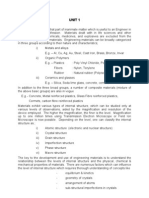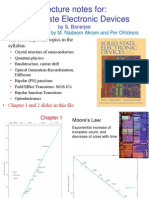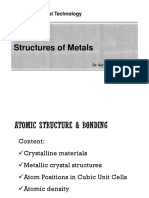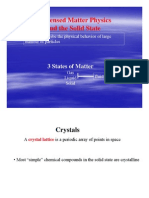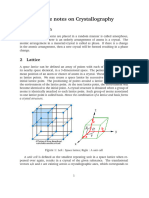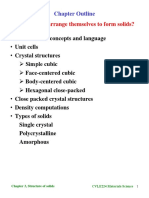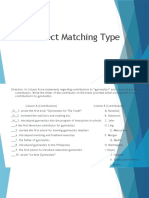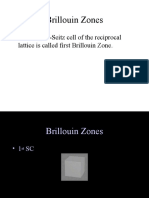Chapter 3
Chapter 3
Uploaded by
antihero86Copyright:
Available Formats
Chapter 3
Chapter 3
Uploaded by
antihero86Original Description:
Copyright
Available Formats
Share this document
Did you find this document useful?
Is this content inappropriate?
Copyright:
Available Formats
Chapter 3
Chapter 3
Uploaded by
antihero86Copyright:
Available Formats
Office Hours
Dr. M. Julian
Tuesday and Thursday right after this
class.
My office is in Collegiate Square over the
gym in MSE Suite 302. My name is on the
door.
Chapter 3
Crystals
perfect order
outline
Crystals
Unit cell
2-D simple, face centered
3-D simple, FCC, BCC, hexagonal
Density
2-D directions and planes
3-D directions and planes
Braggs law and X-ray diffraction
A crystal is a solid composed of atoms
arranged in a periodic array.
Lattice: An array of
points in a crystal with
identical neighborhoods
Lattice of a pattern is the array of points in
space with identical neighborhoods.
Lattice is unique to the pattern.
One repeating unit for each lattice point.
Lattice is independent of the origin.
While the lattice is unique to the pattern,
the pattern is not unique to the lattice.
Unit cell: repeat unit of the lattice.
Primitive Unit cell has one motif per cell.
Primitive Unit cell is the smallest repeating unit
of the cell.
For each lattice there is an infinite number of
choices of primitive unit cells.
A multiple cell: more than one motif to the
unit cell.
Three-Dimensional Basis
Vectors, Unit Cells
Definition Of Angstrom
1 = 10
-10
meters
= 0.1 nanometers
= 10
-8
centimeters
lattice
Atoms in
unit cell
a
0
CN
APF
lattice
Atoms in
unit cell
a
0
CN
APF
2- D simple
square
2-D Simple (Primitive) Square
unit cell
a
o
side of repeat cell
r
0
radius of atom
1 atom per unit cell
a
0
4 X = 1
Coordination Number
CN
number of nearest neighbor
atoms
2-D Simple (Primitive) Square
unit cell
a
o
side of repeat cell
r
0
radius of atom
1 atom per unit cell
a
0
4 X = 1
CN =4
2-D Atomic Packing Factor
Area occipied by atoms in unit cell
_____________________________
Area of unit cell
2-D Simple (Primitive) Square
unit cell
a
o
side of repeat cell
r
0
radius of atom
1 atom per unit cell
a
0
4 X = 1
CN =4
a
o
= 2 r
0
APF= tr
0
2
/a
0
2
= tr
0
2
/4 r
0
2
= t/4
APF= 0.785
A =4 r
0
2
lattice
Atoms in
unit cell
a
0
CN
APF
2- D simple
square
1 a
0
= 2 r
0
4 t/4=0.785
2-D Centered Square
unit cell
a
o
side of repeat cell
r
0
radius of atom
2 atom per unit cell
a
0
v 4 X = 1
B 1 x 1 = 1
CN =4
APF= 2 tr
0
2
/ 8 r
0
2
= tr
0
2
/4 r
2
= t/4
APF= 0.785
a
0
a
0
4 r
0
2a
o
2
= 16 r
0
2
a
o
2
= 8 r
0
2
a
o
= 2\2 r
0
A= 8 r
0
2
lattice
Atoms in
unit cell
a
0
CN
APF
2- D simple
square
1 a
0
= 2 r
0
4 t/4=0.785
2-D centered
square
2 a
o
= 2\2 r
0
4 t/4=0.785
3 D Simple (Primitive) Cubic
unit cell
a
o
side of repeat cell
r
0
radius of atom
1 atom per unit cell
v 8 X 1/8= 1
CN =6
a
0
a
o
= 2 r
0
2-D Atomic Packing Factor
Area occupied by atoms in unit cell
__________________
Area of unit cell
3-D Atomic Packing Factor
Volume occupied by atoms in unit cell
__________________
Volume of unit cell
3 D Simple (Primitive) Cubic
unit cell
a
o
side of repeat cell
r
0
radius of atom
1 atom per unit cell
vert: 8 X 1/8= 1
CN =6
a
0
3
0
3
4
r Sphere of Volume t =
3
0
3
0
) 2 (
3
4
r
r
APF
t
=
524 . = APF
a
o
= 2 r
0
6
t
=
lattice
Atoms in
unit cell
a
0
CN
APF
2- D simple
square
1 a
0
= 2 r
0
4 t/4=0.785
2-D centered
square
2 a
o
= 2\2 r
0
4 t/4=0.785
3- D simple
cubic
1 a
0
= 2 r
0
6 t/6=0.524
3-D Face Centered Cubic
unit cell
a
o
side of repeat cell
a
0
r
0
radius of atom
v 8 X 1/8 = 1
F 6 x = 3
4 atom per unit cell
a
o
= 2\2 r
0
CN =12
74 . 0 ) 2 2 /(
3
4
4
3 3
= t = r r APF
lattice
Atoms in
unit cell
a
0
CN
APF
2- D simple
square
1 a
0
= 2 r
0
4 t/4=0.785
2-D centered
square
2 a
o
= 2\2 r
0
4 t/4=0.785
3- D simple
cubic
1 a
0
= 2 r
0
6 t/6=0.524
3- D face
centered cubic
4 a
o
= 2\2 r
0
12 0.74
Body Centered Cubic
lattice
Atoms in
unit cell
a
0
CN
APF
2- D simple
square
1 a
0
= 2 r
0
4 t/4=0.785
2-D centered
square
2 a
o
= 2\2 r
0
4 t/4=0.785
3- D simple
cubic
1 a
0
= 2 r
0
6 t/6=0.524
3- D face
centered cubic
4 a
o
= 2\2 r
0
12 0.74
3-D Body
Centered
Cubic
HW HW Hw HW
Hexagonal Closest Packing
lattice
Atoms in
unit cell
a
0
CN
APF
2- D simple
square
1 a
0
= 2 r
0
4 t/4=0.785
2-D centered
square
2 a
o
= 2\2 r
0
4 t/4=0.785
3- D simple
cubic
1 a
0
= 2 r
0
6 t/6=0.524
3- D face
centered cubic
4 a
o
= 2\2 r
0
12 0.74
3-D Body
Centered
Cubic
HW HW HW HW
Hexagonal
Closest
Packing
EC EC EC EC
Metal
Crystal
Structure
a
Atomic
Radius
b
(nm) Metal
Crystal
Structure
Atomic
Radius
(nm)
Aluminum FCC 0.1431 Molybdenum BCC 0.1363
Cadmium HCP 0.1490 Nickel FCC 0.1246
Chromium BCC 0.1249 Platinum FCC 0.1387
Cobalt HCP 0.1253 Silver FCC 0.1445
Copper FCC 0.1278 Tantalum BCC 0.1430
Gold FCC 0.1442 Titanium () HCP 0.1445
Iron () BCC 0.1241 Tungsten BCC 0.1371
Lead FCC 0.1750 Zinc HCP 0.1332
Polonium PO PC 0.3359 Z = 84
Stacking
Hexagonal Closest Packing
Cubic Closest Packing
Cubic Closest Packing
Hexagonal Closest Packing
Density
where
n= number of atoms in unit cell
A = atomic weight
V= volume of unit cell
N
A
= Avogadros number (6.023 x 10
23
atoms/mol)
A
VN
nA
volume
mass
density = = =
Density of Copper
Where
n= number of atoms in unit cell
A = atomic weight
V= volume of unit cell
N
A
= Avogadros number (6.023 x 10
23
atoms/mol )
Atomic radius 0.128 nm
Structure FFC
Atomic weight 63.5 g/mol
Density ???? g/cm3
( )
23
3
2 9
10 * 023 . 6 * 10 * 10 * 128 . 0 * 2 2
5 . 63 * 4
=
Calculated Density = 8.89 gm/cm
3
Experimental Density = 8.94gm/cm
3
A
VN
nA
volume
mass
density = = =
Material Atomic Wt g/mol Density g/cc Atomic radius, nm
A 43.1 6.40 0.122
B 184.4 12.3 0.146
C 91.6 9.6 0.137
4
2
1
structure n volume
S 1 (2r)
3
FCC 4 (22r)
3
BCC 2 (4r/3)
3
A
VN
nA
volume
mass
density = = =
S FCC BCC
Crystallographic Direction
A crystallographic direction is a vector between two lattice points
in which the direction is indicated by [u v w] where u, v, and w are
integers that do not contain a common integer factor, except one.
The integers u, v, and w are called the indices of the
crystallographic direction and specify an infinite set of parallel
vectors.
2 D Crystallographic Direction
a
b
[11]
a
b
[10]
a
b
[21]
a
b
3 D Crystallographic Direction
Crystallographic Plane
A lattice plane connects three non-collinear lattice points.
A crystallographic plane is a set of parallel lattice planes. There are
an infinite number of parallel lattice planes.
Miller indices are three relatively prime integers, hkl, that are
reciprocals of the fractional intercepts that the crystallographic plane
makes with the crystallographic axes.
a
b
(21)
a
b
(01)
a
b
) 1 2 (
Crystallographic Plane
Modulus of Elasticity (GPa)
Metal [100] [110] [111]
Aluminum 63.7 72.6 76.1
Copper 66.7 130.3 191.1
Iron 125.0 210.5 272.7
Tungsten 384.6 384.6 384.6
Braggs Law
d- spacing
Braggs law
X-ray diffraction camera
Diffraction angle
d-spacing cubic
a
a
a
d
2
=
a
a
(11)
d
2 a
2 2
1 1
2
+
= =
a a
d
2 2 2
l k h
a
d
+ +
=
d-spacing cubic
a
a
(hk)
d
{(a/h)
2
+ (a/k)
2
}
2 2
k h
a
d
+
=
a/h
a/k
d-spacing for iron
structure hkl a, lattice
parameter
BCC 2 2 0 0.2866
2 2 2
l k h
a
d
hkl
+ +
=
2 2 2
220
0 2 2
2866 .
+ +
=
nm
d
nm d 1013 . 0
220
=
Braggs Law
X-ray Powder Diffraction Camera
incident beam
diffracted
beam
undeviated beam
crystal
plane
film
Calcium
fluoride
Diffraction angle iron
structure hkl a, lattice
parameter
,
wavelength
of x-rays
d
220
BCC 2 2 0 0.2866 0.1790 nm 0.1013 nm
13 . 62
884 . 0
1013 . 0 * 2
1790 .
2
sin
220
220
220
=
= = =
u
u
d
n
n
Diffraction angle = 124.26
n= 2 d
hkl
sin
hkl
Effects Of Temperature On
The Lattice Parameters
Isotropic properties of a material are those properties that
are independent of direction.
Anisotropic properties are those properties that depend on
direction.
For example, some crystals have isotropic thermal
expansion properties and others are anisotropic. The unit cell
parameters a, b, and c often change at different rates.
Effects Of Temperature On
The Lattice Parameters
The linear coefficient of thermal expansion, o
l
, at
constant pressure for a particular lattice parameter is
defined as
o
l
=
P P
T
l ln
T
l
l
|
.
|
\
|
c
c
=
|
.
|
\
|
c
c 1
where l is the lattice parameter, T is the temperature, and P
is the pressure. The data are recorded at a single pressure, so
the pressure is constant.
Effects Of Temperature On
The Lattice Parameters
The linear coefficient of thermal expansion, o
l
, at
constant pressure for a particular lattice parameter is
defined as
o
l
=
P P
T
l ln
T
l
l
|
.
|
\
|
c
c
=
|
.
|
\
|
c
c 1
Urea data
T, Temperature, K
a,
c,
188 5.61365 4.69524
198 5.61652 4.69680
208 5.61902 4.69698
218 5.62233 4.69706
228 5.62423 4.69821
238 5.62731 4.69882
1.724
1.725
1.726
1.727
1.728
1.729
1.73
1.731
1.732
1.733
150 170 190 210 230 250 270 290 310 330 350
T, temperature, K
l
n
(
a
,
l
a
t
t
i
c
e
p
a
r
a
m
e
t
e
r
,
a
n
g
s
t
r
o
m
)
Effects Of Temperature On
The Lattice Parameters
The linear coefficient of thermal expansion, o
l
=
P P
T
l ln
T
l
l
|
.
|
\
|
c
c
=
|
.
|
\
|
c
c 1
1.724
1.725
1.726
1.727
1.728
1.729
1.73
1.731
1.732
1.733
150 170 190 210 230 250 270 290 310 330 350
T, temperature, K
l
n
(
a
,
l
a
t
t
i
c
e
p
a
r
a
m
e
t
e
r
,
a
n
g
s
t
r
o
m
)
Example For urea calculate the linear coefficient of thermal expansion
for the lattice parameter a.
Solution: From the data in table, plot
the natural logarithm of the lattice
parameter a vs. temperature.
The equation of the least squares line
that fits the data is
ln a = 5.23 x 10
-5
T + 1.7154
where a is the lattice parameter and T
is the temperature in K.
The slope in Equation 1.8 is the linear
coefficient of thermal expansion.
Thus
o
l
= 5.23 x 10
-5
K
-1
Effects Of Pressure On The
Lattice Parameters
upper
diamond
lower
diamond
Anthracene sample
external
force
external
force
gasket
fluid inside
gasket
Effects Of Pressure On The
Lattice Parameters
Pressure
GPa
a
, angstroms
b
,
angstroms
c
, angstroms
|
degrees
0.00 8.5319 6.0044 11.1482 124.5774
1.05 8.1099 5.8435 10.8806 125.2857
2.45 7.8850 5.7461 10.7518 125.7366
The linear coefficient of compressibility, |
, for a particular
lattice parameter at constant temperature is defined as
|
l
= -
T T
P
l ln
P
l
l
|
.
|
\
|
c
c
=
|
.
|
\
|
c
c 1
where l is the lattice parameter, T is the temperature, and P is the pressure. The minus
sign indicates that usually the lattice parameter decreases with increasing pressure.
Effects Of Pressure On The
Lattice Parameters
Pressur
e
GPa
a
,
angstroms
b
,
angstroms
c
,
angstroms
|
degrees
0.00 8.5319 6.0044 11.1482 124.5774
1.05 8.1099 5.8435 10.8806 125.2857
2.45 7.8850 5.7461 10.7518 125.7366
The linear coefficient of compressibility, |
l
, for a particular
lattice parameter at constant temperature is defined as
|
l
= -
T T
P
l ln
P
l
l
|
.
|
\
|
c
c
=
|
.
|
\
|
c
c 1
where l is the lattice parameter, T is the temperature, and P is the pressure. The minus
sign indicates that usually the lattice parameter decreases with increasing pressure.
1.9
1.95
2
2.05
2.1
2.15
2.2
0 5 10 15 20 25
P, pressure, GPa
l n
(
a
, l a
t
t
i c
e
p
a
r
a
m
e
t
e
r
, a
n
g
s
t
r
o
m
)
Effects Of Pressure On The
Lattice Parameters
The linear coefficient of compressibility, b
l
, for a particular
lattice parameter at constant temperature is defined as
|
l
= -
T T
P
l ln
P
l
l
|
.
|
\
|
c
c
=
|
.
|
\
|
c
c 1
where l is the lattice parameter, T is the temperature, and P is the pressure. The minus
sign indicates that usually the lattice parameter decreases with increasing pressure.
1.9
1.95
2
2.05
2.1
2.15
2.2
0 5 10 15 20 25
P, pressure, GPa
l n
(
a
, l a
t
t
i c
e
p
a
r
a
m
e
t
e
r
, a
n
g
s
t
r
o
m
)
( ) 2 /
1 2
1 2
2 1
,
2 1 2 1
2
P P P P
P P
a a
a a
+
~
(
= | |
The mean linear compressibility between two
pressures is
where a
1
and a
2
are the values of the lattice parameter at
the corresponding pressures, P
1
and P
2
.
Effects Of Pressure On The
Lattice Parameters
( ) 2 /
1 2
1 2
2 1
,
2 1 2 1
2
P P P P
P P
a a
a a
+
~
(
= | |
The mean linear compressibility between two
pressures is
where a
1
and a
2
are the values of the lattice parameter at
the corresponding pressures, P
1
and P
2
.
Example Calculate the mean linear compressibility for
anthracene for lattice parameter a between pressures of 6.07
and 6.70 GPa.
Solution: Use Table 1.3 and Equation 1.10 to get
GPa GPa 36 . 3 70 . 6 , 07 . 6
07 . 6 70 . 6
5646 . 7 5408 . 7
5408 . 7 5646 . 7
2
| | ~
(
=
= 0.005002 GPa
-1
= 5.0 MPa
-1
Pressure
GPa
a
, angstroms
6.07 7.5646
6.70 7.5408
You might also like
- Solid Geometry FormulasDocument7 pagesSolid Geometry FormulasZack D. SnutssNo ratings yet
- Chapter 3 / MaterialDocument39 pagesChapter 3 / MaterialmuslemNo ratings yet
- Emm Unit 1Document135 pagesEmm Unit 1Aniket KolekarNo ratings yet
- Crystal Structures - Class 1Document77 pagesCrystal Structures - Class 1vijayabanu2013No ratings yet
- Chapter 1 - Energy Bands andDocument134 pagesChapter 1 - Energy Bands andYew Keong NgNo ratings yet
- Solid State 1234567 PDFDocument65 pagesSolid State 1234567 PDFPameela AmalNo ratings yet
- Chapter 03 AnnotDocument4 pagesChapter 03 AnnotNur Amira Mardiana ZulkifliNo ratings yet
- Lecture 3: The Structure of Crystalline Solids: Issues To Address..Document25 pagesLecture 3: The Structure of Crystalline Solids: Issues To Address..Martin TrejoNo ratings yet
- EP104 Sen LNT 003a Crystal Structure May11Document60 pagesEP104 Sen LNT 003a Crystal Structure May11Walid AliNo ratings yet
- Crystallography and Structure - Ch3F10-2Document66 pagesCrystallography and Structure - Ch3F10-2Syeda Fatima FarzamNo ratings yet
- Tema 4: Química Del Estado Sólido: Dr. Jorge CernaDocument27 pagesTema 4: Química Del Estado Sólido: Dr. Jorge CernaSusan FernandezNo ratings yet
- CH 03Document54 pagesCH 03akilNo ratings yet
- Material Science (Unit 1)Document18 pagesMaterial Science (Unit 1)Gaurav AgarwalNo ratings yet
- Crystallography and Structure: ME 2105 R. R. LindekeDocument66 pagesCrystallography and Structure: ME 2105 R. R. LindekeMohammad RameezNo ratings yet
- Crystal Structure (21!10!2011)Document71 pagesCrystal Structure (21!10!2011)Swetha PrasadNo ratings yet
- lecture 4Document14 pageslecture 4www.mohaalrafy361No ratings yet
- EGR250HW No.3Document12 pagesEGR250HW No.3homNo ratings yet
- Ikatan Atom Dan Struktur KristalDocument47 pagesIkatan Atom Dan Struktur KristalIlham WiraNo ratings yet
- Important Chap3 1 SemiImportant Chap3-1-Semiconductor-1.pdf Conductor 1Document67 pagesImportant Chap3 1 SemiImportant Chap3-1-Semiconductor-1.pdf Conductor 1Muhammad Ali AbroNo ratings yet
- The Structure of Crystalline SolidDocument32 pagesThe Structure of Crystalline SolidRakesh Lingayat100% (2)
- Chapter 3Document21 pagesChapter 3Waleed ShakilNo ratings yet
- Organizacion AtomicaDocument99 pagesOrganizacion AtomicaJoel ParrNo ratings yet
- 1-Structure of Solids (Metals)Document41 pages1-Structure of Solids (Metals)karu320No ratings yet
- Ch03 - The Structure of Crystalline SolidsDocument40 pagesCh03 - The Structure of Crystalline SolidsShafiq HafizullahNo ratings yet
- BMT ManualDocument23 pagesBMT ManualAsheesh KumarNo ratings yet
- Unit-I Crystal Structures and Deformation of MaterialsDocument51 pagesUnit-I Crystal Structures and Deformation of Materialsprem16velaniNo ratings yet
- Solid Sate ChemistryDocument46 pagesSolid Sate ChemistryManahil UbaidNo ratings yet
- Crystalline StructureDocument23 pagesCrystalline StructureJuvita Hamizah SouminNo ratings yet
- Lecture Notes For: Solid State Electronic Devices: With Modifications by M. Nadeem Akram and Per OhlckersDocument45 pagesLecture Notes For: Solid State Electronic Devices: With Modifications by M. Nadeem Akram and Per OhlckersSaleha QuadsiaNo ratings yet
- Chapter 3 Structures of Metals 2023 - March 23Document33 pagesChapter 3 Structures of Metals 2023 - March 23NUR ZAHIRAH BINTI ZAINAL ABIDIN BK21110189No ratings yet
- Crystal and Amorphous Structure in MaterialsDocument57 pagesCrystal and Amorphous Structure in MaterialsAmir AyobNo ratings yet
- Introduction To CrystallographyDocument144 pagesIntroduction To CrystallographyV Sree Suswara SuswaraNo ratings yet
- Condensed Matter Physics and The Solid StateDocument40 pagesCondensed Matter Physics and The Solid StategitanoganaNo ratings yet
- Solid State Physics1Document75 pagesSolid State Physics1Rishabh NagdaNo ratings yet
- CrystallographyDocument11 pagesCrystallographydiyasr0105No ratings yet
- Cation Vs AnionDocument16 pagesCation Vs AnionnobleskyNo ratings yet
- JIF 419 - Webex 1 (10.9.2016) - Structure of A CrystalDocument22 pagesJIF 419 - Webex 1 (10.9.2016) - Structure of A CrystalmareasanthaNo ratings yet
- Crystal Structures: Unit-IDocument69 pagesCrystal Structures: Unit-Irahul_patil85No ratings yet
- 03 - Crystal Structures of MetalsDocument8 pages03 - Crystal Structures of MetalsJant Erbert GarbosoNo ratings yet
- Crystal StructureDocument47 pagesCrystal Structurenaz_qd358No ratings yet
- Material Science and MetallurgyDocument44 pagesMaterial Science and MetallurgyRishi JhaNo ratings yet
- EP UNIT NewDocument20 pagesEP UNIT Newtejav2468No ratings yet
- Struktur KristalDocument22 pagesStruktur KristalsulisNo ratings yet
- Lesson 4.0 Basic Concepts of Crystalline StructureDocument11 pagesLesson 4.0 Basic Concepts of Crystalline StructureyoureqtNo ratings yet
- Ikatan Kimia Zat Padat - 2Document67 pagesIkatan Kimia Zat Padat - 2Benedict DavidNo ratings yet
- Mms Module 1 NotesDocument19 pagesMms Module 1 NotesArvidNo ratings yet
- W2 Chapter 2Document37 pagesW2 Chapter 2shahrulmizashahNo ratings yet
- Crystal Structure of MetalsDocument31 pagesCrystal Structure of MetalsTanzir Musa100% (2)
- MSE - Lecture 11Document39 pagesMSE - Lecture 11Atul kumar AryaNo ratings yet
- Course Outline: Part 1: Free Electron TheoryDocument43 pagesCourse Outline: Part 1: Free Electron TheorySabar AliNo ratings yet
- How Do Atoms Arrange Themselves To Form Solids?: Simple CubicDocument29 pagesHow Do Atoms Arrange Themselves To Form Solids?: Simple CubicAbduljabbar Tudu IbrahimNo ratings yet
- Unit 4 Crystal StructureDocument58 pagesUnit 4 Crystal Structurerohinisonje18No ratings yet
- Material Science and MetallurgyDocument43 pagesMaterial Science and MetallurgySanjay Kumar SinghNo ratings yet
- Metals: Major Classes of MaterialsDocument104 pagesMetals: Major Classes of MaterialsalhotleNo ratings yet
- Material Science Cht04 and Cht08Document43 pagesMaterial Science Cht04 and Cht08Arnaldo Bester67% (3)
- Chapt 04Document22 pagesChapt 04Jesse McClureNo ratings yet
- Electron Beam-Specimen Interactions and Simulation Methods in MicroscopyFrom EverandElectron Beam-Specimen Interactions and Simulation Methods in MicroscopyNo ratings yet
- Chapter-8 Unit 4Document13 pagesChapter-8 Unit 4Jar Riane BranzuelaNo ratings yet
- Solid State Class B.sc. 4th Year Lectureby Sitaram BhattaraiDocument137 pagesSolid State Class B.sc. 4th Year Lectureby Sitaram BhattaraitazerstyNo ratings yet
- Perfect Matching TypeDocument8 pagesPerfect Matching TypeJohn Angelo EraNo ratings yet
- SAED in TEMDocument13 pagesSAED in TEMbishnukoiry0% (1)
- Lecture1 Electronics and Its ApplicationsDocument23 pagesLecture1 Electronics and Its Applicationsaribamatloob09No ratings yet
- Mineral Seri Reaksi BowenDocument6 pagesMineral Seri Reaksi BowensenjaNo ratings yet
- Crystallography: Branch of Physics Which Deals With The Arrangement of Atoms or Molecules in MatterDocument19 pagesCrystallography: Branch of Physics Which Deals With The Arrangement of Atoms or Molecules in MatterNirban SahaNo ratings yet
- Geometric Figures and Solids in INstrumental DrawingDocument29 pagesGeometric Figures and Solids in INstrumental Drawingpieyummy699No ratings yet
- Arithmetic Volumes PDFDocument4 pagesArithmetic Volumes PDFVinodNo ratings yet
- Introduction Crystal PhysicsDocument118 pagesIntroduction Crystal PhysicsSilambarasan Physics60% (5)
- Bravais LatticeDocument3 pagesBravais Latticeel_koptan00857693No ratings yet
- Brillouin Zones: - The Wigner-Seitz Cell of The Reciprocal Lattice Is Called First Brillouin ZoneDocument10 pagesBrillouin Zones: - The Wigner-Seitz Cell of The Reciprocal Lattice Is Called First Brillouin ZoneSuresh DevarajiNo ratings yet
- Instructions and AnswersDocument6 pagesInstructions and Answersdani12345678910No ratings yet
- Limbaga - XRD LibraryDocument76 pagesLimbaga - XRD LibraryEDISON LIMBAGANo ratings yet
- Reciprocal Lattice 1Document6 pagesReciprocal Lattice 1hatem100% (1)
- Conversion of Unit Volume (Review)Document17 pagesConversion of Unit Volume (Review)Adi ApriyantoNo ratings yet
- Regular Stellated Polyhedra or Kepler-Poinsot Polyhedra by OrigamiDocument15 pagesRegular Stellated Polyhedra or Kepler-Poinsot Polyhedra by OrigamiGUMUCIONo ratings yet
- @StudyTime - Channel Maths-13Document12 pages@StudyTime - Channel Maths-13Sipra PaulNo ratings yet
- Crystal FormDocument16 pagesCrystal FormAzizah SusilawatiNo ratings yet
- 5 2 2f-Worksheet-2Document1 page5 2 2f-Worksheet-2heaven baxterNo ratings yet
- CHEM20024 Lecture Notes 04 - CrystalsDocument53 pagesCHEM20024 Lecture Notes 04 - CrystalsEzriel QuantumNo ratings yet
- 5 Isometric 131-150Document53 pages5 Isometric 131-150mithravindaa.vNo ratings yet
- Vaagdevi Institute of Technology and Sciences Peddasettypalli Engineering Drawing Question Paper UNIT-4Document6 pagesVaagdevi Institute of Technology and Sciences Peddasettypalli Engineering Drawing Question Paper UNIT-4proddaturNo ratings yet
- Volume Problem Attic Flashcards Without Answer KeyDocument25 pagesVolume Problem Attic Flashcards Without Answer Keyapi-290509627No ratings yet
- Volume Surface AreaDocument47 pagesVolume Surface AreakarmaNo ratings yet
- Q4 ST 1 GR.6 Math With TosDocument3 pagesQ4 ST 1 GR.6 Math With Tosrochelle littauaNo ratings yet
- Building 2D and 3D Geometric Shapes With Marshmallows & ToothpicksDocument16 pagesBuilding 2D and 3D Geometric Shapes With Marshmallows & ToothpicksDidaktica AmirNo ratings yet
- LAS DRAWING-Q2-Classification of Drawing Tools With Answer KeyDocument3 pagesLAS DRAWING-Q2-Classification of Drawing Tools With Answer KeyMarc Donnell VillaNo ratings yet
- Crystal SymmetryDocument20 pagesCrystal Symmetryyoyo mohanNo ratings yet












